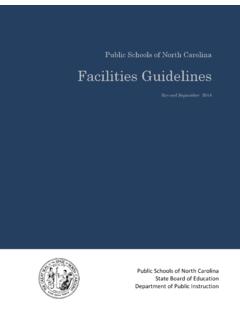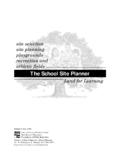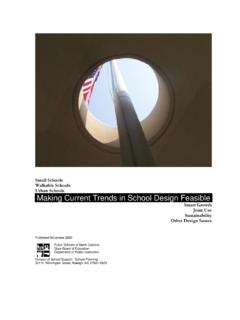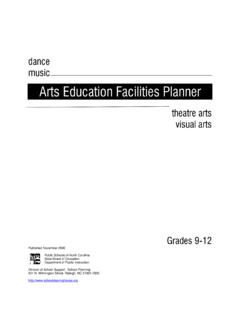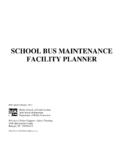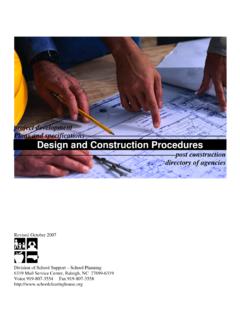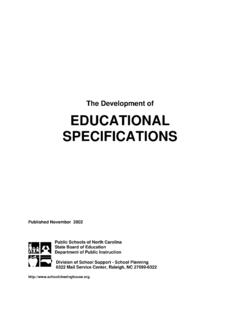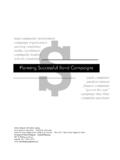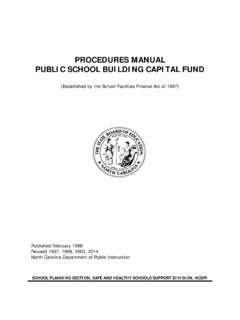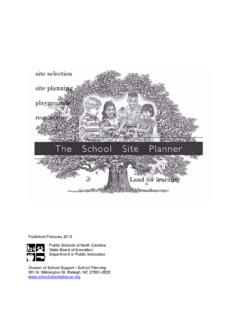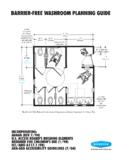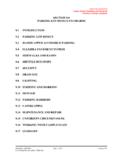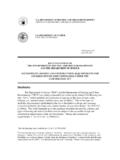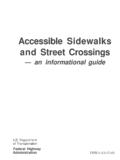Transcription of Exceptional Children Facilities Planner
1 Exceptional Children Facilities Planner guidelines for designers September 2010 Department of Public Instruction Division of School Support / School Planning Section 301 North Wilmington Street Raleigh, NC 27601 Exceptional Children Facilities Planner School Planning Section N C Department of Public Instruction September 2010 ii blank page iii FOREWORD Programs for Exceptional Children comprise a unique and growing component of the North Carolina Standard Course of Study for students to age 21. Facilities that support instruction for Exceptional Children must be carefully designed around the students needs and capabilities, and also interrelate with the overall school design.
2 Instructing in the least restrictive environment often means that many Exceptional Children are taught in typical classrooms most or all of the day. The rapid pace of technological change and evolving pedagogical theory surrounding the instruction of Exceptional Children require innovation and flexibility in the design of Facilities . Designers, school administrators, and teachers must plan together to determine the most appropriate configuration to meet current and projected needs, while retaining a degree of flexibility necessary to accommodate future programs. Long-term economy and usability are essential to achieving progressive educational agendas. This publication describes Facilities for Exceptional Children , and as such is a supplement to the North Carolina Public Schools Facilities Guidelines. It is meant as a resource to assist design professionals to plan Facilities that meet the evolving needs of public schools in North Carolina.
3 We hope you find it useful. William C. Harrison, Chair June St. Clair Atkinson State Board of Education State Superintendent North Carolina Department of Public Instruction In compliance with federal law, including the provisions of Title IX of the Education Amendments of 1972, the North Carolina Department of Public Instruction does not discriminate on the basis of race, sex, religion, color, national or ethnic origin, age, disability, or military service in its policies, programs, activities, admissions or employment. Inquiries or complaints should be directed to: the Office of Curriculum and School Reform Services 6307 Mail Service Center Raleigh, NC 27699-6307 Telephone (919) 807-3761; fax (919) 807-3767iv ACKNOWLEDGMENTS This document is a collaborative effort.
4 The Department of Public Instruction gratefully acknowledges the contributions of the following, without whom the development of this publication would have been difficult. Members of the document committee: Susan Davis; Personal Development Consultant Nancy Dominick; Policy, Monitoring & Audit Claire Greer; Autism, Severe & Multiple Disabilities Lauren Holahan; Occupational Therapy Consultant, UNC-CH Julie Kagy; Visual Impairment Assistive Team Freda Lee; Intellectual Disabilities Consultant PIPD Section Rachael Ragin; Consultant, Deaf & Hard of Hearing Heather Reynolds; PBS Consultant Tom Winton, Section Chief, Instructional Support & Related Services Kenneth Phelps; Architect / School Planning Consultant, Principal Author Reviewers: Roger Ballard, ; Consulting Architect Bob Bryan, ; Consulting Electrical Engineer Johnny Clark, ; Consulting Mechanical Engineer Greg Flynn, RA; Consulting Architect Pam Ray; Program Assistant Mary Spradling, Statistical Research Analyst Steve Taynton, AIA.
5 Section Chief, School Planning Gerry Solomon, School Library Media Consultant Cynthia Sartain, Technology Consultant v TABLE OF CONTENTS Foreword ..iii Acknowledgements ..iv Introduction ..1 Educational Class Size Requirements ..3 Background and Context ..5 Programming ..7 Preliminary Universal Design ..9 Special Education Facility Standards General Skills and Targeted Skills ..13 Sustained Support and Intensive Needs ..15 Illustrative plans of , 20 Support Services Media Dining, Physical Education, and Resource Psychological Renovations of Existing Overview of The School Campus and Appendices 1. Categories of Eligibility ..37 2.
6 Laws and Regulations .. 41 3. Acoustics ..43 4. Lighting and the Visually Impaired ..51 5. Evacuating & Sheltering Exceptional Children ..53 6. Seclusion / 7. Miscellaneous ABBREVIATIONS ABA architectural barriers Act of 1968 (PL 90-480) Access Board The architectural and Transportation barriers Compliance Board ADA Americans with Disabilities Act of 1990 (PL 101-336) ADAAG ADA Accessibility Guidelines for Buildings and Facilities (advisory only) ADA Standards ADA Standards for Accessibility Design (legally enforceable) ANSI American National Standards Institute CFR Code of Federal Regulations EC Exceptional Children FAPE free appropriate public education GS General statutes IDEA Individuals with Disabilities Education Act of 1990 (PL 101-476), an amended and renewed version of the Education for All Handicapped Children Act of 1975 (PL 94-142)
7 IEP individualized education program LEA local education agency LRE least restrictive environment MGRAD Minimum Guidelines and Requirements for Accessible Design (advisory only) NCDPI North Carolina Department of Public Instruction. See website at OSEP Office of Special Education Programs, Department of Education Section 502 & 504 sections of Title V of the Rehabilitation Act of 1973 (PL 93-112) UFAS Uniform Federal Accessibility Standards (legally enforceable) 1 INTRODUCTION Few components of the program for modern school design present a greater challenge to the designer than do Facilities to meet the widely varied needs of Exceptional Children (EC).
8 These are students who, because of permanent or temporary mental, physical, or emotional disabilities are unable to have all of their educational needs met in a regular classroom without special educational and/or related services. While philosophy and law dictate that Children with special needs should be placed in the least restrictive environment (LRE) [educated with non-disabled peers to the greatest extent possible], many cannot succeed in the traditional classroom, or even in one having some modification. It is therefore sometimes necessary to provide instructional spaces designed especially for Exceptional Children . A further complication to the designer and to his/her clients is that the Children with special needs, and the type and severity of their needs, may vary dramatically from one academic term to another, and from one school to another across the district. In addition, on-going review and revision of applicable regulations and guidelines necessitate a significant degree of flexibility in the physical facility.
9 Some Exceptional Children may spend their entire day in the traditional classroom; some may be pulled out for various lengths of time, at varying schedule, for instruction or activities, therapy, or other functions in additional spaces. Other Children , with more profound needs, may be schooled primarily or totally in specially designed and equipped classrooms. It has generally been the policy to design Facilities for Exceptional Children in terms of a particular disability or situation exhibited by the students. That is, previous manuals provided guidance organized by categories of disabilities, such as autistic, or visually impaired, or mentally disabled, to name a few. Current practice is to categorize the needs of the students by extent (severity) of the educational need, rather than by the type of a particular disabling condition. These categories of service delivery are as follows: SPECIAL EDUCATION / GENERAL SKILLS SPECIAL EDUCATION / TARGETED SKILLS SPECIAL EDUCATION / SUSTAINED SUPPORT SPECIAL EDUCATION / INTENSIVE NEEDS For descriptions of these categories, see Policies Governing Services for Children with Disabilities, following.
10 [From NC DPI policy 1508, pages 139-140.] However, in order better to grasp the type of disabilities for which the designer is involved, and to coordinate current criteria with past practice, it may be instructive to understand the areas of eligibility for special education. These are described in Appendix 1, Categories of Eligibility. Programs for Exceptional Children are intended to ensure that each student develops mentally, physically, socially, emotionally, and vocationally to the fullest extent possible, 2 through appropriate individualized education. These guidelines are intended to assist in the design of Facilities to enhance that endeavor. Using the Facility Planner This publication is intended to be a reference document for designers of school Facilities . Its purpose is to provide descriptions of programs and Facilities for Exceptional Children , which can support their needs.
